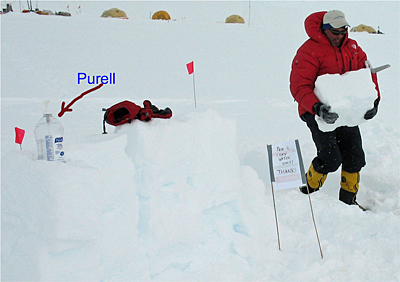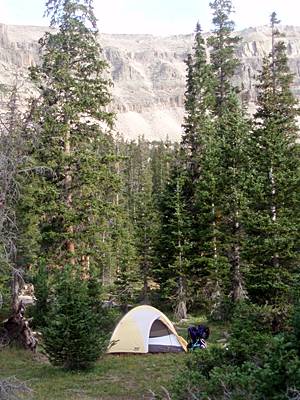In Camp

Keep latrine and gray water areas separate from all water sources, especially in wilderness areas like Antarctica. And don’t forget the Purell.
(photo: B. Straka)
Whenever and wherever you camp, you must make sure your water supply is not contaminated, as well as take great care not to contaminate the water supply. To prevent contamination, separate your water source from the areas for bodily relief and washing dishes or yourself by at least 100 feet (or as specified by the land manager).
Designate a clean water source area and a separate latrine area when you set up camp. If there is a latrine or outhouse available, make this the designated latrine area. Emphasize to everyone in your party (adults and youth) that they must use the designated latrine area, and must not just step outside the tent during the night or first thing in the morning. When designating the latrine area, keep in mind that other people may be using the area in the future. In winter, consider the impact when the snow melts.
In Winter
It is tempting to think that snow, especially in winter, is uncontaminated, but this is not necessarily true. Avoid yellow or brown snow, but also keep in mind that animals roam the snowfields and can contaminate the snow, just as humans do. Purify the water, just as in summer. If you are melting snow, continue heating it up to the boiling point. While it’s obvious when thinking about it, the shovel or scoop used for gathering snow to melt into water should be different from the shovel used for the latrine or other purposes.
In Wilderness Areas
In an increasing number of wilderness areas, camping and backpacking groups are required to carry out all human waste. This can be accomplished by using one of the commercial waste bags (RestStop or WAG Bags, for example) or by using doubled plastic garbage bags.
In the latter example, one garbage bag is used as a liner, either for a bucket carried in for that purpose (some groups carry a toilet seat for the can) or for a hole dug for that purpose. The person changing the liner bag should wear disposable gloves (the same type of surgical gloves everyone should have in their first aid kits), tightly close and tie-wrap the liner bag, and place it inside a second bag, which is also tightly closed and tie-wrapped. The now-contaminated gloves are disposed of in the new liner bag. A handful of cat litter can help reduce odor and will make the operation less unpleasant for the designee.
In winter, waste matter usually freezes quickly. To reduce volume, reserve the bags for fecal matter and have people urinate a short distance away. The bags can be emptied into a latrine or a dumpster at the trailhead (check with the local land managers for their standardized practices).
During a Natural Disaster
It is also important to be aware of the potential contamination of water supplies during natural disasters, such as earthquakes in California, floods in the Midwest, and hurricanes in the Gulf States. While this does not relate directly to camping, knowledge and practice in dealing with water supplies in the backcountry can help with preparedness for natural disasters or other interruptions of normal water supplies.
Clean Hands

A clean backcountry camp includes keeping nearby water sources uncontaminated. (photo: A. MacLeay)
Cleanliness is more difficult in the backcountry. It is important that the cook always has clean hands, as should everyone when eating (especially finger foods like sandwiches). Certainly, the person on latrine duty should not also be the cook. And when rotating duties, do not have the latrine person’s next task involve food preparation. If possible, the latrine person should thoroughly wash his or her hands with soap and water.
Do not wash your hands in any stream, lake, or spring. That is your water supply and that of other parties and the local wildlife. You can carry a folding basin for this purpose; do the washing at least 100 feet from water sources. Alternatively, use the sterilizing solutions or gels, such as Pure Touch and Purell, found in many drug, grocery, and camping stores.
Clean Dishes
Rinsing soap off dishes, especially aluminum pots, requires enough hot water that the extra fuel to be carried becomes a significant factor. Part of the solution to having clean dishes is to prepare foods that produce minimal mess. Much of the mess can be cleaned off dishes and cooking utensils by scrubbing with snow and following with a hot water rinse (remember to pack out all food waste!). Also, remember to dispose of any soapy wash or rinse water in an ecologically sound manner, at least 100 feet from water sources.
You can also clean dishes as much as possible at the end of each meal, then sterilize dishes, cups, spoons, etc. in boiling water just before use in the water to be used for cooking.
Continued in “Part 3: What is in Backcountry Water?” »
Read Water Treatment and Storage Reviews »

 by Bill Straka
by Bill Straka









